Do you have some 1996 pennies and wonder if they might be worth more than their face value?
While most pennies from this year are common pocket change, certain rare examples—especially those in mint condition or with striking errors—can be worth hundreds or even thousands of dollars to collectors.
In this article, we’ll take a closer look at:
- The history and design of the 1996 Lincoln penny
- How to estimate its value based on condition, mint mark, and color
- And what makes some 1996 pennies particularly valuable, from high-grade specimens to dramatic mint errors
Whether you’re a beginner coin collector or just stumbled across an old penny in your drawer, read on to see if you might be holding a hidden gem.
History of the 1996 Penny

The 1996 penny is part of the Lincoln cent series, featuring Abraham Lincoln on the obverse, a design first introduced in 1909. The reverse side still shows the Lincoln Memorial, which was used from 1959 to 2008.
Minted in Philadelphia (no mint mark) and Denver (with “D” mint mark), the 1996 penny was made of copper-plated zinc, a composition used since 1982. Over 10 billion pennies were produced in 1996, making it a very common coin in circulation.
While most 1996 pennies have little collector value due to their high mintage and lack of significant errors, some may be worth more if they are in uncirculated condition or have minting errors, such as off-center strikes or die cracks.
1996 Penny Details
- Category: Lincoln Penny
- Mints: Philadelphia, Denver, San Francisco
- Total Mintage: 13,125,785,265
- Obverse Designer: Victor David Brenner
- Reverse Designer: Frank Gasparro
- Edge: Smooth
- Diameter: 19.05 mm (0.75 inches)
- Thickness: 1.52 mm (0.05983 inches)
- Weight: 2.5 grams (0.08818 ounces)
- Composition: 97.5% Zinc, 2.5% Copper (Copper-plated Zinc)
- Face Value: $0.01
- Melt Value: $0.005 (as of current base metal prices)
Obverse Design of the 1996 Lincoln Penny
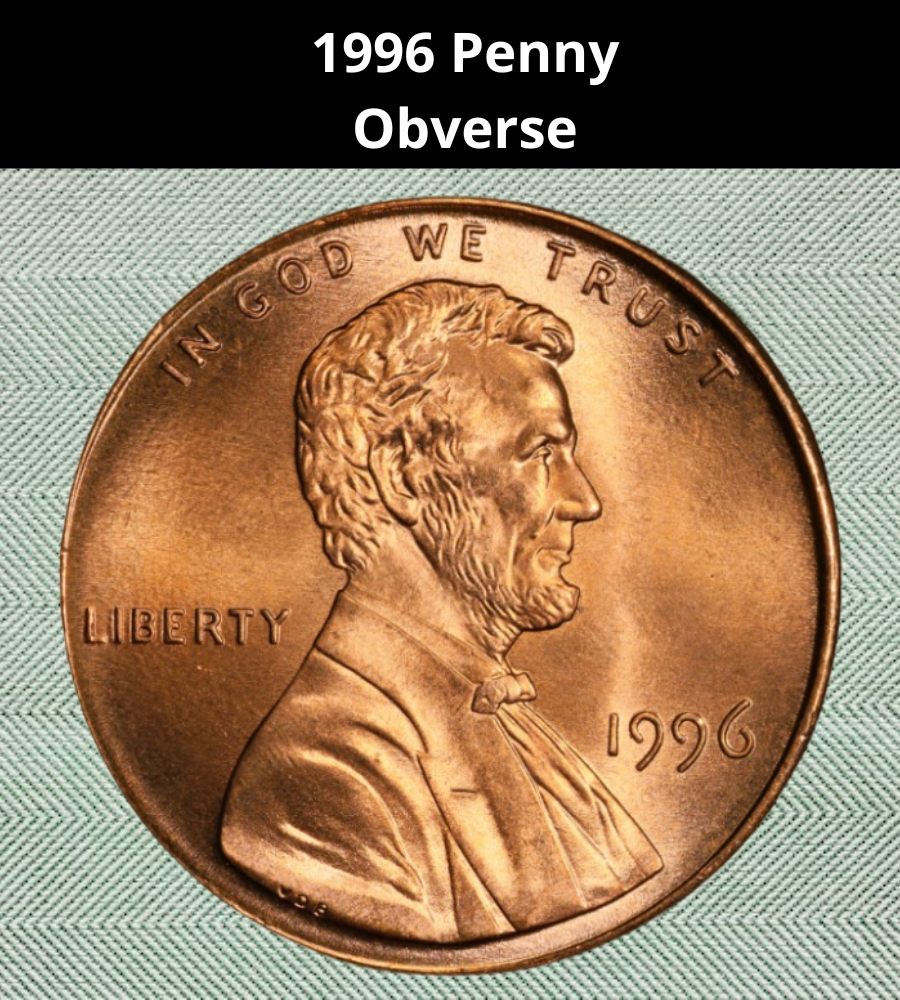
The obverse (or “heads” side) of the 1996 Lincoln penny features the iconic portrait of President Abraham Lincoln, facing right. This design, created by Victor David Brenner, was first introduced in 1909 to commemorate Lincoln’s 100th birthday, making it the longest-running portrait on any U.S. coin.
Key details include:
- The motto “IN GOD WE TRUST” arches across the upper rim above Lincoln’s head.
- The word “LIBERTY” appears to the left, behind Lincoln.
- The year “1996” is located in front of Lincoln’s profile, just beneath the bowtie area.
- If present, a mint mark (“D” for Denver or “S” for San Francisco) appears directly below the date. Coins from Philadelphia do not carry a mint mark.
The size of the date is noticeably larger than the other inscriptions on the obverse, adding visual balance to the coin’s design.
Reverse Design of the 1996 Lincoln Penny
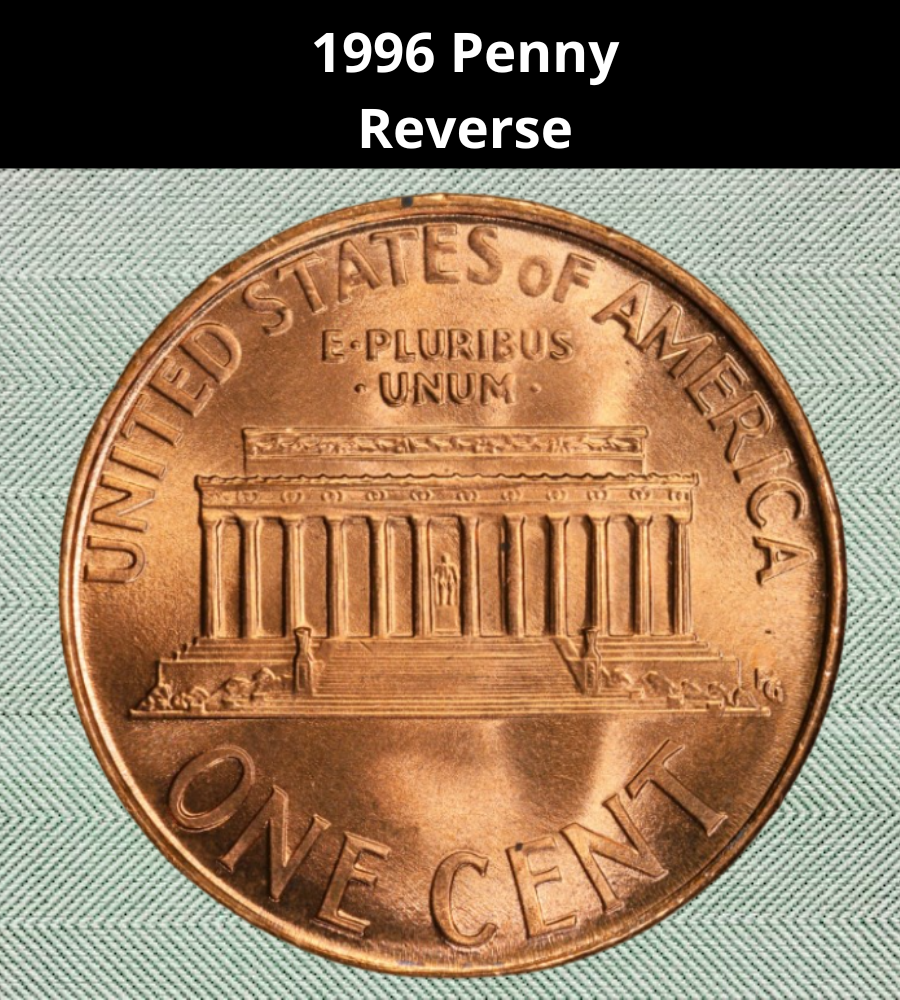
The reverse side of the 1996 penny features the Lincoln Memorial, one of the most recognizable monuments in the United States, located in Washington, D.C. This design was created by Frank Gasparro, the Chief Engraver of the U.S. Mint, and was introduced in 1959 to commemorate the 150th anniversary of Abraham Lincoln’s birth.
Key Features:
- The Lincoln Memorial is depicted in neoclassical style, modeled after ancient Greek temples.
- The building showcases twelve clearly defined Doric columns, symbolizing strength and stability.
- At the center, between the pillars, a tiny yet distinct statue of Lincoln is visible — a rare instance where a U.S. coin shows the same person on both sides.
- Above the building is the Latin motto “E PLURIBUS UNUM”, meaning “Out of many, one.”
- Curving along the upper rim is the text “UNITED STATES OF AMERICA” in capital letters.
- At the bottom of the reverse, the coin’s denomination “ONE CENT” appears in a large, bold font.
This design remained on the reverse of Lincoln pennies until 2008, after which it was replaced by various bicentennial designs in 2009, and eventually by the Union Shield in 2010.
1996 Lincoln Penny Value Chart
| Mint Mark | MS65 | MS67 | MS68 |
|---|---|---|---|
| 1996 (P) – No Mint Mark | $10 | $28 | $125 |
| 1996 D – Denver | $10 | $24 | $60 |
| 1996 S – San Francisco (Proof) | $4 | $6 | $7 |
Note: These values apply to coins in “Red” (RD) condition for business strikes and Deep Cameo (DCAM) for proofs.
1996 Lincoln Penny Grading (Sheldon Scale)
| Grade Number | Grade Description | Notes |
|---|---|---|
| 1 | Basal State | Barely identifiable coin |
| 2 | Fair | Very heavily worn |
| 3 | Very Fair | Still very worn, some details show |
| 4–6 | Good | Major features visible, but very worn |
| 7–10 | Very Good | More design visible, but still flat |
| 12–15 | Fine | Some moderate detail remains |
| 20–30 | Very Fine | More detail visible, moderate wear |
| 40 | Extremely Fine | Light wear on high points |
| 50 | About Uncirculated | Slight traces of wear |
| 60–70 | Mint State (MS) | Uncirculated, no wear |
| 60–70 (Proofs) | Proof (PR) | Special mirror-like coins, collector-only |
1996 Penny Value and Varieties Guide
1996 No Mint Mark Penny Value
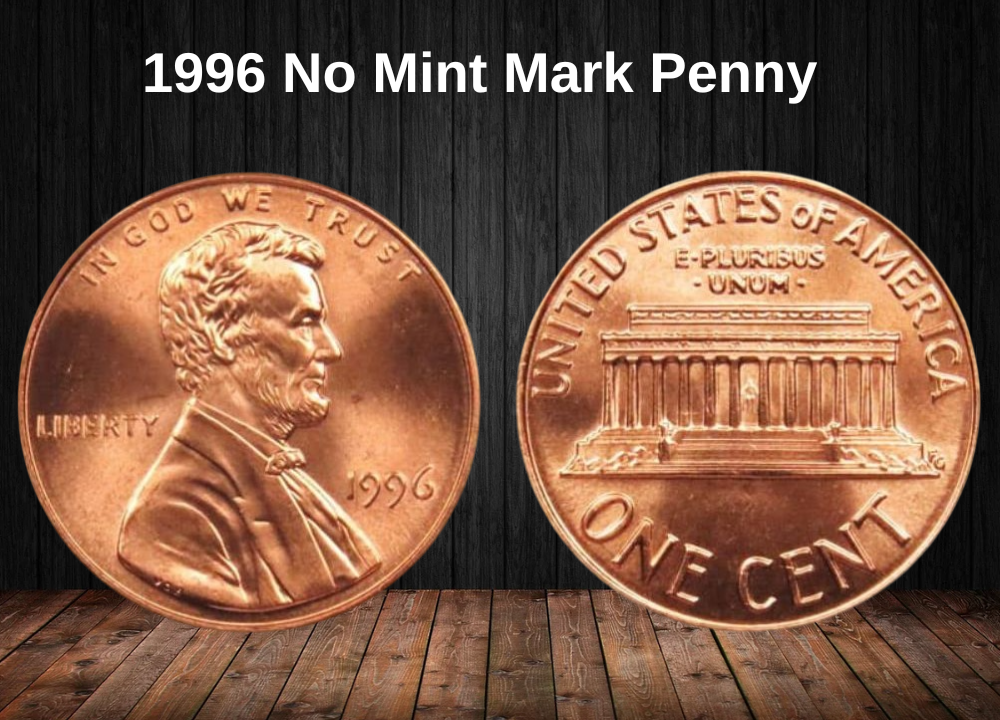
| Feature | Details |
|---|---|
| Type | Lincoln Memorial Penny |
| Mint Mark | None (No Mint Mark = Philadelphia Mint) |
| Year of Minting | 1996 |
| Mint Location | Philadelphia |
| Quantity Produced | 6,612,465,000 |
| Designers | Obverse: Victor D. Brenner Reverse: Frank Gasparro |
| Edge | Smooth |
| Composition | 97.5% Zinc, 2.5% Copper (copper-plated zinc) |
| Weight | 2.5 grams |
| Face Value | $0.01 |
| Melt Value | ~$0.005 (Not worth melting) |
Value Guide for 1996 No Mint Mark Penny
| Condition | Color | Estimated Value |
|---|---|---|
| Circulated | — | $0.01 (Face value) |
| Mint State (MS60–MS64) | Red/Brown | $0.10–$0.34 |
| Mint State MS65 | Red | ~$10 |
| Mint State MS67 | Red | ~$28 |
| Mint State MS68+ | Red | Up to $2,500 (eBay, 2018 sale example) |
Important: Color affects value. “Red” coins (95%+ red) are the most valuable.
1996 D Penny Value
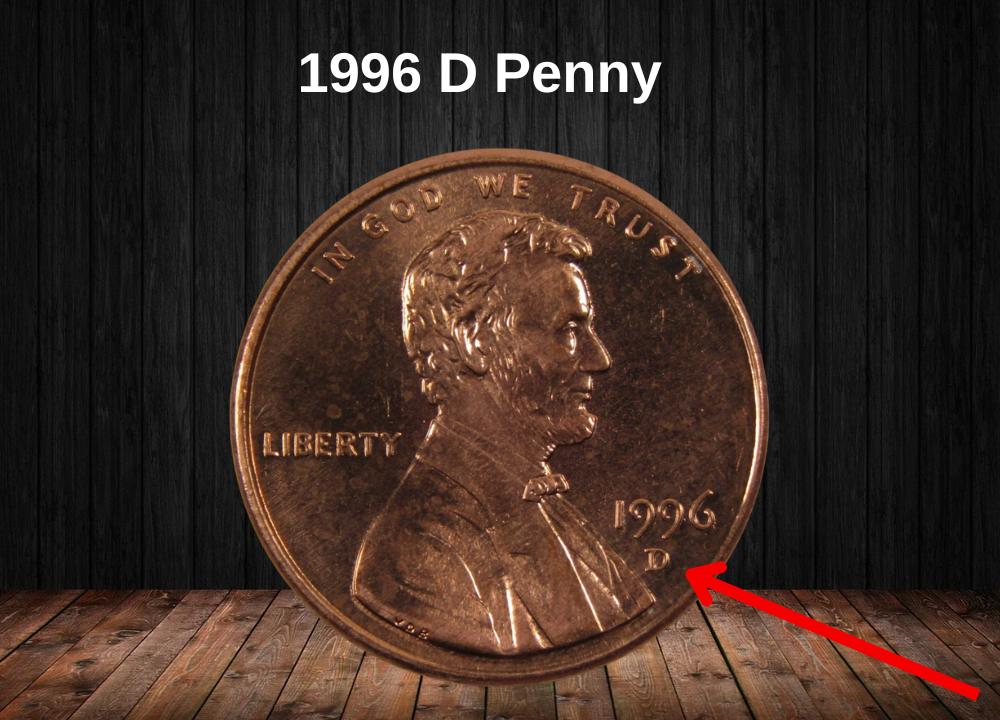
| Feature | Details |
|---|---|
| Type | Lincoln Memorial Penny |
| Mint Mark | D (Denver Mint) |
| Year of Minting | 1996 |
| Mint Location | Denver |
| Quantity Produced | 6,510,795,000 |
| Designers | Obverse: Victor D. Brenner Reverse: Frank Gasparro |
| Edge | Smooth |
| Composition | 97.5% Zinc, 2.5% Copper (copper-plated zinc) |
| Weight | 2.5 grams |
| Face Value | $0.01 |
| Melt Value | ~$0.005 |
Value Guide for 1996-D Lincoln Penny
| Condition | Color | Estimated Value |
|---|---|---|
| Circulated | — | $0.01 (Face value) |
| Mint State MS65 | Red | ~$10 |
| Mint State MS67 | Red | ~$24 |
| Mint State MS68 | Red | ~$60 |
| Mint State MS69 | Red | $3,565 (Baltimore Auction, 2008) |
Note: High-grade examples (MS68 and MS69) are rare and command premium prices.
1996 S Penny Value
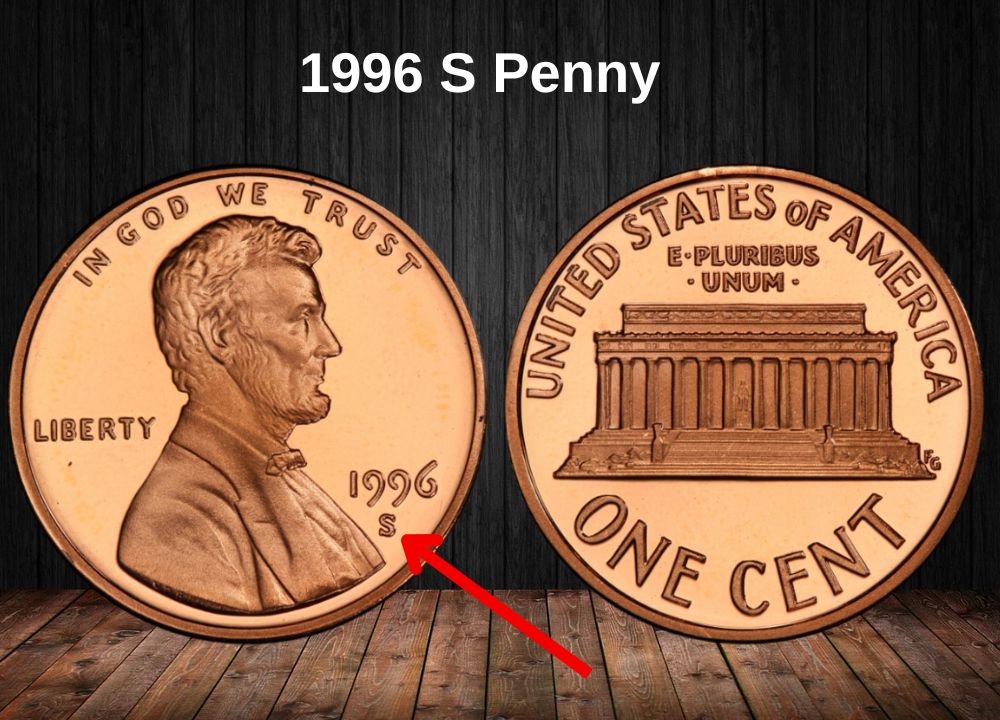
| Feature | Details |
|---|---|
| Type | Lincoln Memorial Penny (Proof Only) |
| Mint Mark | S (San Francisco Mint) |
| Year of Minting | 1996 |
| Mint Location | San Francisco |
| Quantity Produced | 2,525,265 (All Proof Coins) |
| Designers | Obverse: Victor D. Brenner Reverse: Frank Gasparro |
| Edge | Smooth |
| Composition | 97.5% Zinc, 2.5% Copper (Copper-plated Zinc) |
| Weight | 2.5 grams |
| Face Value | $0.01 |
| Melt Value | ~$0.005 |
Value Guide for 1996-S Proof Lincoln Penny
| Grade | Designation | Estimated Value |
|---|---|---|
| PR60 | Deep Cameo (DCAM) | ~$1 |
| PR65 | DCAM | ~$4 |
| PR68 | DCAM | ~$6 |
| PR69 | DCAM | ~$7 |
| PR70 | DCAM | $1,610 (record sale in 2003) |
Note: All 1996-S proof pennies are typically Deep Cameos due to modern proofing standards. Most examples are in excellent condition, so the coin must be flawless (PR70 DCAM) to command a high premium.
Rare 1996 Lincoln Penny Errors List
1996 Lincoln Penny Wide AM Error
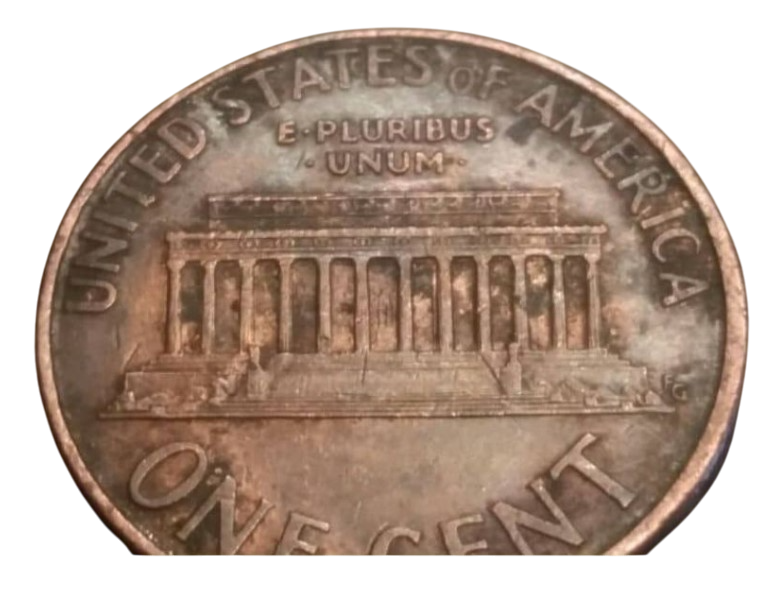
A small number of 1996 Lincoln pennies produced at the Philadelphia Mint display a subtle but valuable design difference on the reverse side: a noticeably wider gap between the letters “A” and “M” in the word “AMERICA”.
While most pennies from this year feature a Close AM configuration—where the letters almost touch—some were mistakenly struck using a proof reverse die, resulting in the Wide AM spacing. This variety is relatively scarce compared to the standard version.
Collectors often seek out this type, and its market value can rise significantly depending on the coin’s condition. Higher-grade examples, especially those in mint state, tend to fetch the highest prices.
1996 Lincoln Penny Doubled Die Error
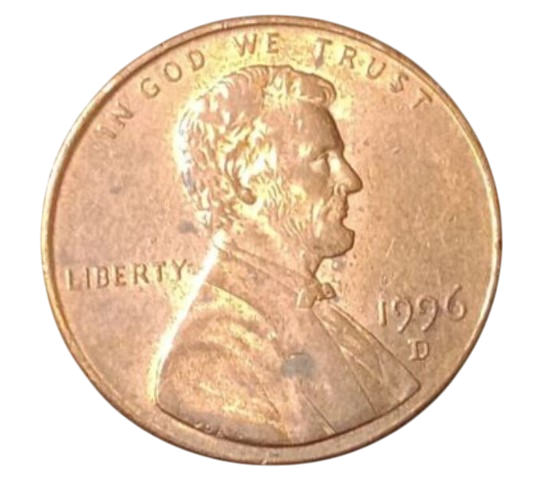
A small number of 1996 Lincoln cents were produced with a doubled die, a striking mistake that results in duplicated design elements on the coin. This occurs during the die creation process, when the design is impressed more than once but slightly misaligned.
On the 1996 penny, this error can often be spotted on Lincoln’s eye and bowtie on the front, as well as between the columns of the Lincoln Memorial on the reverse.
Coins with strong, noticeable doubling tend to command higher prices, while those with faint doubling are less valuable. Most 1996 doubled die pennies are worth between $20 and $50, depending on clarity and condition.
1996 Lincoln Penny Off-Center Error
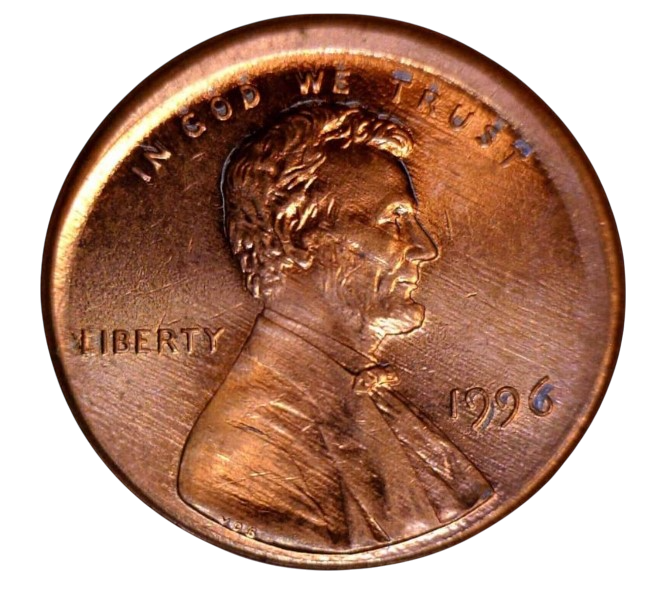
An off-center error occurs when a coin blank (planchet) isn’t properly aligned within the press during minting, causing the design to be imprinted off-center. The degree of misalignment can vary significantly—from barely noticeable (1%–2%) to dramatic examples where up to 90% of the design is missing.
The greater the misalignment, the more collectible and valuable the coin tends to be—provided it’s in good condition. A 1996 penny with a minor 3% off-center strike might bring only a small premium over face value. However, coins with a 5%–10% misalignment can fetch up to $10, while those with a 40%–60% off-center strike are typically valued between $50 and $100.
1996 Lincoln Penny Die Crack Error
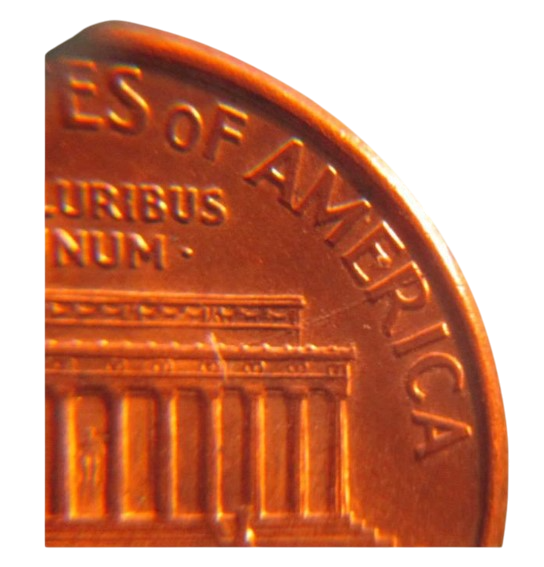
Die crack errors occur when a damaged or aging die develops fractures. As the die strikes coins, these cracks leave raised lines on the coin’s surface. One known variation on 1996 Lincoln pennies is the “BIE” error—a small vertical line that appears between the letters B and E in the word “Liberty”, giving the illusion of an extra letter “I”.
Collectors find these quirky flaws interesting, and depending on the size and visibility of the crack, BIE error coins from 1996 typically sell for between $5 and $15.
Where to sell your penny?
Now that you know the value of your penny, you might be wondering where to sell it. Don’t worry: here’s a guide to some of the best online platforms where you can easily sell your coins, along with their advantages and disadvantages.
Discover the best platforms for selling coins online (pros and cons).
1996 Lincoln Penny FAQs
1. What is the composition of the 1996 Lincoln penny?
The 1996 Lincoln penny is composed of 97.5% zinc and 2.5% copper. It has a zinc core with a thin copper plating, a standard composition used since mid-1982.
2. Which mints produced the 1996 Lincoln penny?
The 1996 penny was minted at three U.S. Mint facilities:
- Philadelphia (no mint mark),
- Denver (“D” mint mark),
- San Francisco (“S” mint mark) for proof coins only.
3. Are there any notable errors or varieties in the 1996 penny?
Yes. Collectors look for errors such as:
- Off-center strikes
- Die cracks and cuds
- Double strikes
While no major doubled die varieties are confirmed, minor errors can still hold collector value.
4. What is the typical value of a 1996 penny?
- Circulated coins: Face value (1 cent)
- Uncirculated coins: $0.10 to $1+ depending on condition
- Proof coins (1996-S): $1–$3+
- Error coins: Value varies based on rarity and demand
5. What design is featured on the 1996 Lincoln penny?
- Obverse: Abraham Lincoln’s bust by Victor D. Brenner
- Reverse: Lincoln Memorial, used from 1959 to 2008
It’s part of the long-running Lincoln Memorial Cent series.
6. How many 1996 pennies were minted?
- Philadelphia: ~6.6 billion
- Denver: ~6.5 billion
- San Francisco (Proof): ~2 million
This makes the 1996 penny a very common coin in circulation.
7. Are 1996 Lincoln pennies good for investment?
Generally, circulated 1996 pennies are not valuable for investment. However, MS67+ graded coins, proof coins, or error coins may hold value for collectors.


















































